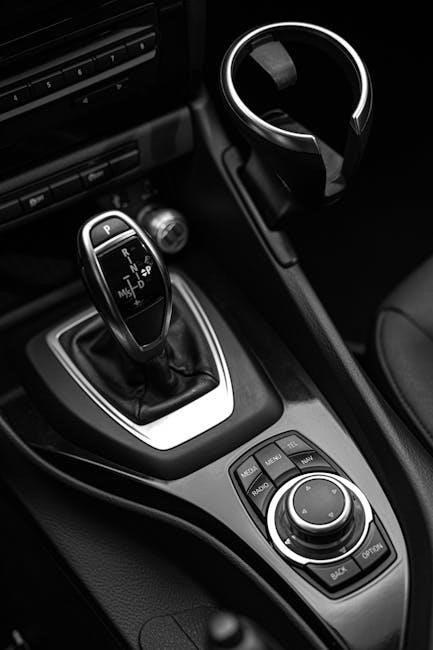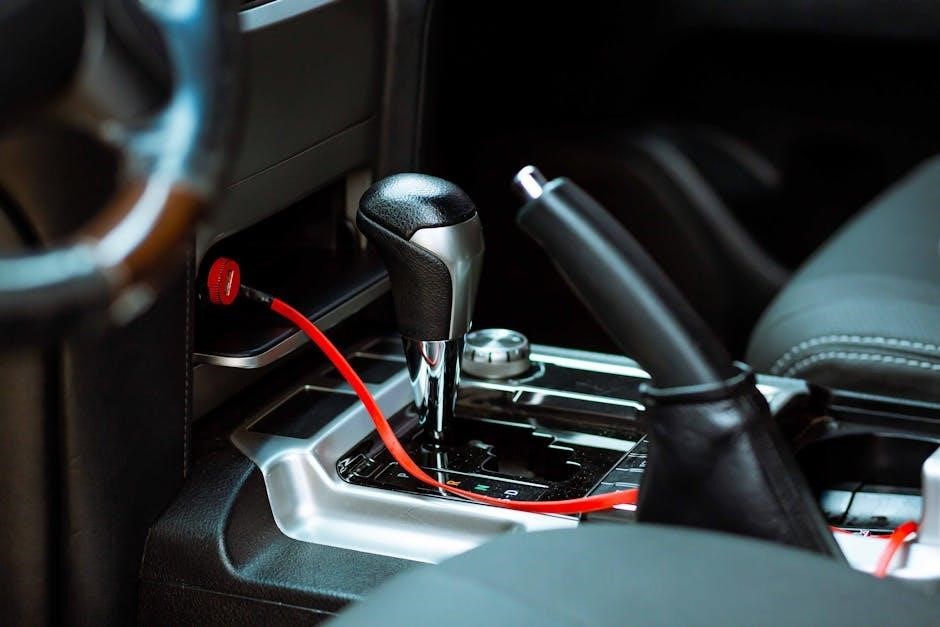Cuisinart 2 Qt Ice Cream Maker Manual: A Comprehensive Guide
This manual provides detailed instructions for operating your Cuisinart ice cream maker, offering guidance on TikTok’s mobile video platform,
and ensuring delightful frozen desserts every time, with easy-to-follow steps․
Welcome to the world of homemade frozen treats! The Cuisinart 2-quart ice cream maker empowers you to create delicious ice cream, frozen yogurt, and sorbet with ease․ This appliance is designed for simplicity and convenience, bringing the joy of artisanal desserts directly to your kitchen․ TikTok, known as Douyin in China, highlights the maker’s popularity․
This manual serves as your comprehensive guide, walking you through each step of the process – from initial setup and freezing the bowl, to mixing, and enjoying your creations; Whether you’re a seasoned chef or a beginner, this machine offers a user-friendly experience․ PureWow editors recommend it as a standout favorite, praising its performance and versatility․ Get ready to indulge in customized flavors and textures, tailored to your preferences!
Understanding the Components
Your Cuisinart 2-quart ice cream maker consists of several key components․ These include the motor base, the double-insulated 2-quart freezer bowl (made of stainless steel), the bowl holder, and the mixing paddle․ The freezer bowl is crucial, requiring thorough freezing before use – essential for optimal results․ TikTok’s short-form videos demonstrate the ease of use․
The mixing paddle agitates the mixture, incorporating air and creating a smooth, creamy texture․ The motor base powers the paddle, ensuring consistent mixing throughout the freezing process․ Familiarizing yourself with each part is vital for proper assembly and operation․ The unit’s classic silver style complements any kitchen․ Understanding these components will help you troubleshoot and maintain your ice cream maker effectively, ensuring years of delicious enjoyment․
Safety Precautions
Before operating your Cuisinart ice cream maker, please read these safety precautions carefully․ Always unplug the unit before cleaning or disassembling․ Never immerse the motor base in water or other liquids․ Ensure the freezer bowl is completely frozen before attaching it to the motor base – TikTok’s platform shows quick demonstrations․
Do not operate the appliance if the cord or plug is damaged․ Keep hands and utensils away from the moving mixing paddle during operation․ Supervise children when the appliance is in use․ Avoid continuous running for extended periods; allow the motor to rest․ This appliance is for household use only․ Following these guidelines will ensure safe and enjoyable ice cream making, preventing potential hazards and maximizing the lifespan of your Cuisinart machine․

Preparing for Your First Use
Before creating delicious frozen treats, thoroughly wash all removable parts and ensure the freezer bowl is adequately frozen for optimal performance․
Freezing the Bowl: Essential Steps
Achieving the correct bowl temperature is paramount for successful ice cream making․ The Cuisinart 2 Qt Ice Cream Maker requires the freezer bowl to be thoroughly frozen – typically for a minimum of 16-24 hours․ Ensure your freezer is set to 0°F (-18°C) or lower․ Place the bowl directly on a flat freezer shelf, avoiding placement near the freezer door or vents, which can cause inconsistent temperatures․
Before assembly, verify the bowl is completely frozen; liquid should not slosh around when gently shaken․ A partially frozen bowl will result in a soft, soupy mixture instead of creamy ice cream․ It’s recommended to dedicate one bowl solely for ice cream making, as frequent freezing and thawing can compromise its performance․ Consistent freezing is key to enjoying perfectly textured frozen desserts․
Recipe Considerations & Compatibility
The Cuisinart 2 Qt Ice Cream Maker excels with recipes specifically formulated for ice cream makers․ Traditional custard-based recipes, requiring pre-cooking, work exceptionally well, providing a rich and creamy texture․ However, Philadelphia-style (no-cook) recipes are also compatible, offering a quicker preparation time․ Ensure your mixture is thoroughly chilled – ideally below 40°F (4°C) – before pouring it into the frozen bowl․
Avoid recipes with large solid pieces, like chunky cookies, as they can strain the motor․ If adding mix-ins, do so during the last few minutes of churning․ The machine is versatile, handling frozen yogurt and sorbet recipes effectively, but adjust sugar levels accordingly․ Remember, the mixture will expand during freezing, so don’t overfill the bowl beyond the maximum fill line․
Checking the Freezer Bowl Temperature
Ensuring the freezer bowl is adequately frozen is crucial for successful ice cream making․ A minimum of 24 hours in the freezer is generally recommended, even longer for optimal results․ To verify, gently shake the bowl; if you hear no liquid sloshing, it’s likely frozen․ However, a more reliable method is to use a food thermometer․ The internal temperature should be 0°F (-18°C) or lower․
If the bowl isn’t fully frozen, the mixture won’t solidify properly, resulting in a soupy consistency․ Avoid placing the bowl in direct sunlight or near heat sources during the freezing process․ Re-freezing a partially thawed bowl may take another 24 hours․ Consistent freezer temperature is key; avoid frequent opening and closing of the freezer door․

Operating the Ice Cream Maker
This section details the assembly and operation of your Cuisinart machine, guiding you through adding mixtures and monitoring the freezing process for perfect results․
Assembling the Unit
Before beginning, ensure the freezer bowl is thoroughly frozen – this is crucial for successful ice cream making․ Begin by placing the dasher assembly into the bowl․ The dasher, comprised of the blade and paddle, is responsible for mixing and incorporating air into your ice cream base․
Carefully position the bowl onto the base unit, aligning the arrow on the bowl with the arrow on the base․ A secure fit is essential; the unit will not operate if the bowl isn’t properly locked into place․ Next, attach the clear cover onto the bowl, ensuring it clicks securely․
The cover features a feed tube for adding mix-ins during the freezing process․ Finally, plug in the ice cream maker, and you’re ready to begin! Double-check all components are correctly assembled before proceeding to avoid any operational issues․
Adding the Ice Cream Mixture
With the unit assembled, carefully pour your chilled ice cream mixture into the freezer bowl through the feed tube on the cover․ Do not overfill; leave at least one inch of space at the top of the bowl to allow for expansion during the freezing process․ Overfilling can prevent proper churning and result in a soupy consistency․
Ensure the mixture is well-chilled before adding it to the bowl – this significantly reduces freezing time and improves the final texture․ Once the mixture is added, securely attach the lid, ensuring it clicks into place․
Now, turn on the ice cream maker․ The dasher will begin to rotate, initiating the freezing process; Avoid lifting the lid during the initial stages to maintain a consistent temperature․
The Mixing Process: Duration & Monitoring
Allow the ice cream maker to run for approximately 20-25 minutes․ The mixture will gradually thicken as it freezes, and the dasher will become more difficult to turn․ This is a normal part of the process, indicating the ice cream is nearing completion․
Periodically check the consistency of the ice cream․ It should resemble soft-serve ice cream․ If it’s still too liquid after 25 minutes, continue churning for another 5-10 minutes, checking frequently․ Avoid prolonged churning, as this can lead to a grainy texture․
The motor may strain slightly as the mixture thickens; this is expected․ If the motor stalls, turn off the machine and allow the mixture to soften slightly before resuming․

Recipes & Flavor Ideas
Explore a world of frozen delights! From classic vanilla to exciting variations like chocolate, frozen yogurt, and sorbets, unleash your creativity today․
Classic Vanilla Ice Cream Recipe
Ingredients: 2 cups heavy cream, 1 cup whole milk, ¾ cup granulated sugar, 1 tablespoon vanilla extract, and a pinch of salt․ This foundational recipe showcases the Cuisinart’s ability to create smooth, rich ice cream․ Begin by combining the cream, milk, sugar, and salt in a saucepan․
Heat over medium heat, stirring constantly until the sugar dissolves․ Remove from heat and stir in the vanilla extract․ Chill the mixture thoroughly – ideally for at least two hours, or even overnight – to ensure optimal freezing․
Pour the chilled mixture into the frozen freezer bowl of your Cuisinart ice cream maker․ Process for approximately 20-25 minutes, or until the ice cream reaches your desired consistency․ Enjoy immediately for the softest serve, or transfer to a freezer-safe container for a firmer texture․
Chocolate Ice Cream Variation

Ingredients: Follow the Classic Vanilla recipe, adding ½ cup unsweetened cocoa powder and ¼ cup chocolate liquor (optional, for a deeper chocolate flavor)․ Sifting the cocoa powder prevents clumps and ensures a smooth texture․ Incorporate the cocoa powder with the sugar before heating the cream and milk mixture․
The heating process will bloom the cocoa, intensifying the chocolate flavor․ Continue with the chilling process as outlined in the Vanilla recipe․ Before adding to the Cuisinart, taste and adjust sweetness if needed – chocolate can sometimes require a bit more sugar․
Process in the frozen bowl for 20-25 minutes․ For chocolate chips or chunks, add them during the last five minutes of churning․ This prevents them from sinking to the bottom․ Enjoy this decadent variation!
Frozen Yogurt & Sorbet Recipes
Frozen Yogurt: Substitute milk with 2 cups of plain or flavored yogurt in the Vanilla base․ Greek yogurt yields a thicker consistency; adjust liquid if needed․ For a tangier flavor, use less sugar․ Churn as usual, approximately 20-25 minutes․ Add fruit purees or granola during the last few minutes for texture and flavor․
Sorbet: Combine 2 cups water, 1 cup sugar, and 2 cups fruit puree (berries, mango, peach) in a saucepan․ Heat until sugar dissolves, then chill thoroughly․ This Cuisinart maker excels at sorbets! Churn for 15-20 minutes; sorbet freezes faster than ice cream․
Experiment with citrus juices and herbs for unique sorbet creations․ Remember, sorbet consistency is firmer than ice cream․

Cleaning & Maintenance
Proper cleaning ensures longevity․ Disassemble components after each use, wash thoroughly, and store correctly to maintain optimal performance of your Cuisinart machine․
Disassembling the Unit for Cleaning
Before initiating the cleaning process, always ensure the Cuisinart ice cream maker is unplugged from the power outlet․ This is a crucial safety precaution to prevent accidental activation during disassembly․ Begin by removing the freezer bowl; gently twisting it may be necessary if it’s securely fitted․
Next, detach the mixing paddle from the motor assembly․ Typically, this involves lifting it straight up, though a slight rotation might be required․ The clear cover should then be removed, allowing access to the internal components․ Carefully inspect all parts for any remaining ice cream residue․
Remember to keep track of all components during disassembly to ensure a smooth reassembly process later․ A clean, dry workspace will also aid in organization and prevent loss of small parts․ Avoid using abrasive cleaners or scouring pads, as these can damage the surfaces of the components․
Washing the Components: Hand Wash vs․ Dishwasher
The Cuisinart 2 Qt Ice Cream Maker’s components generally offer flexibility in cleaning methods, but with specific considerations․ The freezer bowl must be hand washed only; dishwasher use can compromise its double-walled insulation, impacting future freezing performance․ Use warm, soapy water and a soft sponge to gently clean the bowl․
The mixing paddle, cover, and any other plastic parts are typically dishwasher-safe, ideally on the top rack․ However, hand washing these components with warm, soapy water is also perfectly acceptable and may prolong their lifespan․ Avoid harsh detergents or abrasive cleaners on any part․
Thoroughly rinse all components with clean water and allow them to air dry completely before reassembling the unit․ Ensure no water remains trapped in crevices, as this can lead to mold or mildew growth․
Proper Storage Techniques
Ensuring the longevity of your Cuisinart 2 Qt Ice Cream Maker requires mindful storage practices․ After thorough cleaning and complete drying, store the freezer bowl separately in a freezer-safe bag or wrapping to prevent odor absorption and maintain optimal freezing capability․ The bowl should always be kept in the freezer when not in use․
The motor base, cover, and paddle can be stored in a cool, dry place, away from direct sunlight and extreme temperatures․ Avoid stacking heavy items on top of the motor base, as this could cause damage․
Keeping all components clean and dry before storage is crucial․ Consider storing the unit in its original packaging for added protection during prolonged periods of inactivity․

Troubleshooting Common Issues
Addressing problems like improper freezing or motor stalls is key․ Ensure the bowl is thoroughly frozen, the mixture is cold, and the unit is assembled correctly․
Ice Cream Not Freezing Properly
If your ice cream mixture isn’t freezing, several factors could be at play․ First, verify the freezer bowl is completely frozen – this typically requires at least 24 hours․ A partially frozen bowl won’t achieve the necessary temperature for proper churning․
Next, ensure your ice cream base is adequately chilled before pouring it into the bowl; pre-chilling for several hours significantly improves results․ Also, confirm the unit is assembled correctly, with the dasher properly installed and rotating freely․
Insufficient chilling time for the base, a warm room temperature, or even overfilling the bowl can hinder the freezing process․ TikTok’s short-form videos highlight the importance of preparation, and the same applies here! Finally, check the freezer’s temperature setting to ensure it’s cold enough․
Motor Stalling During Operation
A stalling motor usually indicates the mixture is too thick or frozen, creating excessive resistance․ Immediately unplug the unit and allow the ice cream to soften slightly before attempting to restart․ Avoid overfilling the bowl; exceeding the maximum fill line strains the motor․
Ensure the dasher is correctly positioned and not obstructed․ TikTok’s viral content often showcases quick fixes, but here, patience is key; If the mixture is very dense, try adding a tablespoon or two of liquid (milk or cream) to reduce viscosity․
Consistent monitoring during operation is crucial․ If stalling persists, the motor may be overheating; let it cool down completely before further use․ A faulty motor might require professional repair or replacement․
Bowl Not Staying Frozen
Insufficient freezing of the bowl is the most common cause of this issue․ Verify the bowl was frozen for a minimum of 24 hours, ideally in a freezer set to 0°F (-18°C)․ Avoid frequent freezer door openings, as temperature fluctuations hinder complete freezing․ TikTok trends highlight quick solutions, but proper freezing is fundamental․
Ensure nothing obstructs airflow around the bowl inside the freezer․ A partially thawed bowl won’t maintain the necessary temperature for ice cream creation․ If the bowl consistently fails to freeze, consider a second bowl for continuous use while the first refreezes․
Check your freezer’s temperature with a thermometer to confirm it’s functioning correctly․ A malfunctioning freezer will prevent adequate bowl freezing․

Advanced Techniques & Tips
Explore custom flavors and sweetness levels! TikTok inspires creativity; adjust recipes for perfect consistency, enhancing your Cuisinart experience with personalized frozen delights․
Creating Custom Flavors
Unleash your inner pastry chef! The Cuisinart 2 Qt Ice Cream Maker excels at personalized creations․ Beyond vanilla and chocolate, TikTok’s trending flavors can inspire you․ Infuse your base with fruit purees – strawberry, mango, or raspberry – for vibrant sorbets․ Experiment with extracts like almond, peppermint, or coffee for nuanced ice creams․
Consider adding mix-ins after the initial churn․ Chocolate chips, crushed cookies, nuts, or even swirls of caramel elevate the texture and taste․ Remember to chill mix-ins beforehand to prevent melting․ Don’t be afraid to combine flavors; a chocolate-peanut butter swirl or a lavender-honey ice cream can be surprisingly delightful․
For bolder flavors, steep spices like cinnamon or cardamom in the cream base before churning․ Always taste-test your mixture before freezing to ensure the flavor intensity is to your liking․ TikTok’s community shares countless flavor combinations – explore and adapt!
Adjusting Recipe Sweetness
Controlling sweetness is key to perfect ice cream․ TikTok’s food creators often emphasize balancing flavors․ Standard recipes often call for a significant amount of sugar, but you can adjust this to your preference․ Reducing sugar impacts texture; less sugar results in a icier consistency․ To counteract this, consider adding a tablespoon of corn syrup or glucose to maintain smoothness․
Alternative sweeteners like stevia or erythritol can be used, but may require recipe adjustments as they don’t provide the same bulk or freezing properties as sugar․ Taste your mixture before churning – it will taste less sweet when frozen․
Remember that fruit purees and chocolate also contribute sweetness․ Start with a slight reduction in sugar and adjust in future batches․ TikTok’s recipe experiments can guide you, but personalize to your taste!
Achieving the Perfect Ice Cream Consistency
The ideal ice cream texture is smooth, creamy, and not too icy․ TikTok’s viral ice cream videos showcase this perfectly! Proper freezing of the bowl is paramount, as insufficient freezing leads to a grainy texture․ Ensure your base is thoroughly chilled – at least 4 hours, preferably overnight․
The mixing duration impacts consistency; over-churning can result in a buttery texture, while under-churning leaves it too soft․ Monitor closely․ Adding a stabilizer like guar gum (a tiny amount!) can improve texture, preventing ice crystal formation․
TikTok users often discuss “ripening” – transferring the ice cream to a container and freezing for a few hours to allow flavors to meld and texture to firm up․ Experiment to find your sweet spot!

Warranty Information & Support
Cuisinart provides a limited warranty on this ice cream maker․ For details, contact customer support or visit their website for replacement parts and assistance․
Cuisinart Warranty Details
Cuisinart stands behind the quality of its products, offering a limited warranty on the 2 Qt Ice Cream Maker․ This warranty typically covers defects in materials and workmanship for a period of one year from the date of original purchase․ It’s crucial to retain your proof of purchase, as it’s required for all warranty claims․
The warranty doesn’t cover damage resulting from misuse, accidents, unauthorized repairs, or normal wear and tear․ Specifically, the freezer bowl is often subject to a shorter warranty period, potentially 90 days, due to its susceptibility to damage․ To initiate a warranty claim, you’ll need to contact Cuisinart’s customer support team with your model number and purchase details; They will guide you through the process, which may involve returning the product for inspection or repair․
Remember to review the complete warranty documentation included with your ice cream maker for specific terms and conditions․

Contacting Customer Support
Cuisinart provides multiple avenues for customers needing assistance with their 2 Qt Ice Cream Maker․ For immediate support, you can reach their dedicated customer service team via phone․ The number is readily available on the Cuisinart website and in the product manual․ Alternatively, their website features a comprehensive FAQ section addressing common issues and troubleshooting steps․
Email support is also offered, allowing you to submit detailed inquiries and potentially include photos or videos of the problem․ Response times may vary depending on the volume of requests․ Social media channels, like Facebook and Twitter, can also be used to reach Cuisinart, though response times are generally slower․
When contacting support, have your model number and purchase date handy to expedite the process․
Finding Replacement Parts
Locating replacement parts for your Cuisinart 2 Qt Ice Cream Maker is straightforward․ The official Cuisinart website hosts a dedicated parts store where you can search by model number․ Common replacements include the freezer bowl, mixing paddle, and lid․ Ensure you have your model number readily available for accurate part identification․
Alternatively, authorized Cuisinart retailers, both online and brick-and-mortar, often stock frequently requested parts․ Websites like Amazon and specialized appliance parts retailers are also viable options․ When purchasing from third-party sellers, verify authenticity to ensure compatibility and quality․
For discontinued or hard-to-find parts, contacting Cuisinart customer support directly may yield assistance․ They can advise on potential alternatives or direct you to authorized service centers․




























































